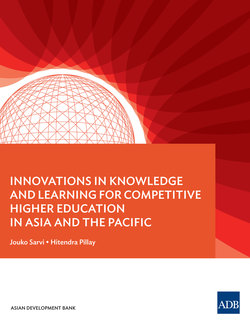Читать книгу Innovations in Knowledge and Learning for Competitive Higher Education in Asia and the Pacific - Jouko Sarvi - Страница 4
На сайте Литреса книга снята с продажи.
Executive Summary
ОглавлениеCompetitive advantage in a knowledge economy is dependent on the ability to innovate and create new knowledge products and services, and to find innovative applications for them. Higher education institutions (HEIs), traditionally, have been considered key agents for human resource development and thus strongly influence countries’ capacity to innovate and become competitive. However, HEIs in Asia and the Pacific, modelled on industrial age thinking that demands excellence in routinized capacities, lack the ability to innovate and create new knowledge enterprises. Consequently, appreciating innovations and creative enterprise requires new lenses; replicating more of the same capacities will not be enough. The transition to a knowledge economy has situated the higher education sector amid an increasingly rapid transformation in education, across dimensions of purpose, content, pedagogy, and methodologies. Technology, social change, increased demand, and the decades-long trend of ever-increasing costs and very supply-side planning have left us with multiple challenges and the need to be highly innovative in an educational culture that tends to be wary of change.
The traditional thinking that HEIs are the sole custodians of knowledge and have the prerogative to determine what constitutes competitive knowledge, innovation, and creative enterprise is being challenged by external nontraditional stakeholders. Increasingly, industry and field experts, among whom much of new knowledge innovation happens, are becoming significant players in the higher education landscape—comprising teaching, research, and community engagement. Therefore, there is pressure to involve professional bodies, industry experts, think tanks, research institutes, and other field experts/practitioners in not just planning program content and delivery processes to stimulate knowledge creation and application, but also as alternative providers of higher education services.
The constructs and typologies of different knowledge types need serious review in order to produce higher education graduates who can be creative and innovate rather than merely excelling in performing routine tasks. Recent research suggests various insights concerning knowledge architecture and classifications aligned with the aspiration for a knowledge economy. Irrespective of the knowledge classification, the common message is a need for convergence of different knowledge types. The traditional model of ”artificial separation of knowledge vs. skills” or soft vs hard knowledge and skills may no longer be relevant. Convergence helps us appreciate the integrated nature of knowledge as it is applied in an everyday context and is central to creativity and innovativeness—one cannot think in silos and be productive in a knowledge economy. This presents challenges for structuring higher education programs when traditional faculty boundaries and ”conventional wisdom” regarding appropriate content are still very much the norm. Furthermore, research and analytical thinking can no longer be left to postgraduate work. In most developed economies these types of knowledge innovation capacities are initiated in undergraduate programs.
Increasingly, recognition of new types of knowledge such as lived experiences, contextual knowledge, and indigenous knowledge has been accompanied by the emergence of constructs such as work-integrated learning, which is permeating all professional disciplines. The separation between formal and informal learning is also becoming blurred due to the ubiquity of knowledge and learning. Increased use of “recognition of prior learning” is being adopted to improve the efficiency of human resource development to provide “job-ready” graduates. The emergence of new disciplines such as creative industries is challenging traditional HEI faculties. The hegemony of global knowledge is also being challenged by nontraditional sources such as developing country, rural, and indigenous knowledge. Inclusive development through increased knowledge sharing between the Anglophone world and others is expanding the scope of knowledge products, services, and applications and changing the expectations of graduates entering the knowledge economy workforce.
Increased access and the ubiquity of knowledge creation and learning confounded by innovations in information and communication technology are disrupting the role of HEIs. The exponential increase in the rate and volume of knowledge products and applications may disrupt traditional structures and timelines of higher education programs if they are to cover the scope and breadth of the knowledge and skills expected of graduates. Flexible modalities, involving external stakeholders and a mix of credit and professional enhancement programs, are gaining recognition as a key part of future higher education service provision. Related to this is the rapid obsolescence of knowledge, which has spawned the growth in continuous professional development (CPD) programs, most of which are modularized and are either delivered online or are site based. To cover the breadth of knowledge types expected by the knowledge workforce, many HEIs provide not-for-credit programs in entrepreneurship and knowledge innovation as value adding and to differentiate themselves from traditional institutions.
The challenge of aligning higher education services (programs) with evolving labor market changes, and responding to knowledge-based economy of respective developing countries, has been difficult for many traditional universities. The majority of universities in the region tend to focus on transferring existing knowledge to produce workers who can apply routinized knowledge in bureaucratic organizations and highly structured private sector work environments. This may be appropriate for some lower income countries and lower middle income countries, but such a workforce can only replicate and sustain current economic activities, not innovate and transform to become competitive knowledge-based economies. To avoid economic stagnation of middle income countries and transform to a knowledge economy, the higher education system needs to go beyond current practices.
